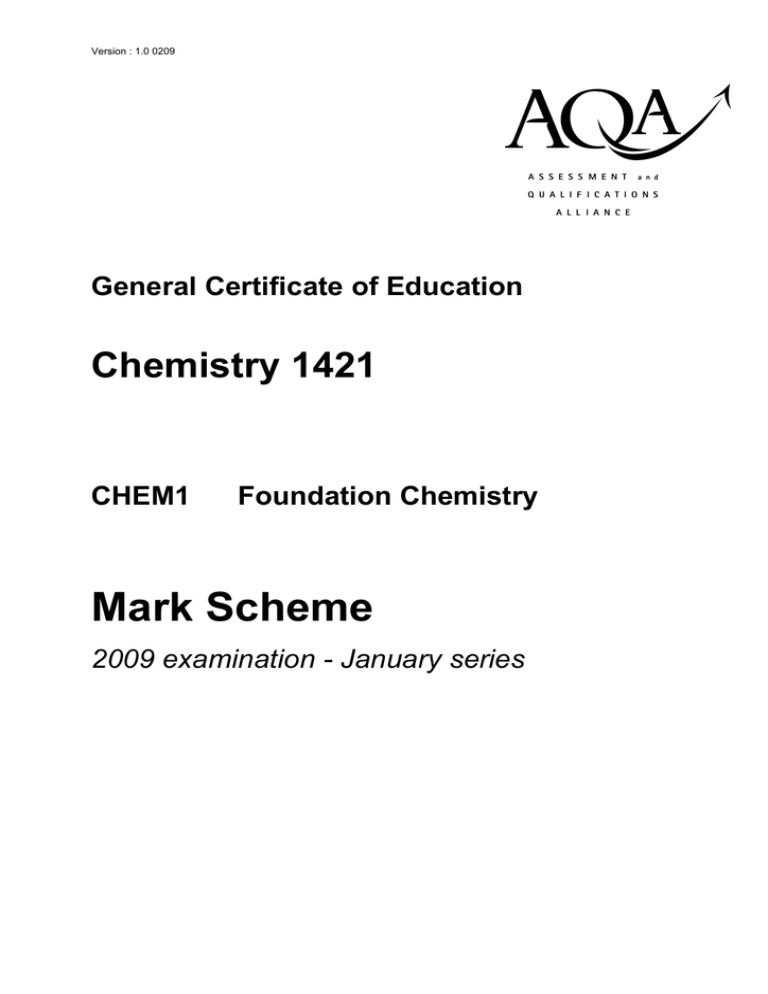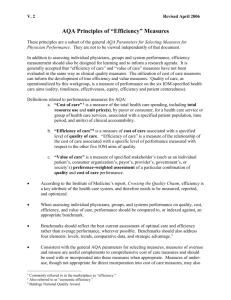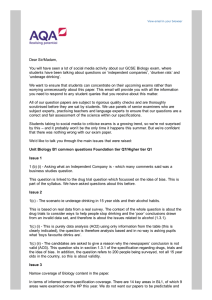
Version : 1.0 0209
abc
General Certificate of Education
Chemistry 1421
CHEM1
Foundation Chemistry
Mark Scheme
2009 examination - January series
Mark schemes are prepared by the Principal Examiner and considered, together with the
relevant questions, by a panel of subject teachers. This mark scheme includes any
amendments made at the standardisation meeting attended by all examiners and is the scheme
which was used by them in this examination. The standardisation meeting ensures that the
mark scheme covers the candidates’ responses to questions and that every examiner
understands and applies it in the same correct way. As preparation for the standardisation
meeting each examiner analyses a number of candidates’ scripts: alternative answers not
already covered by the mark scheme are discussed at the meeting and legislated for. If, after
this meeting, examiners encounter unusual answers which have not been discussed at the
meeting they are required to refer these to the Principal Examiner.
It must be stressed that a mark scheme is a working document, in many cases further
developed and expanded on the basis of candidates’ reactions to a particular paper.
Assumptions about future mark schemes on the basis of one year’s document should be
avoided; whilst the guiding principles of assessment remain constant, details will change,
depending on the content of a particular examination paper.
Further copies of this Mark Scheme are available to download from the AQA Website: www.aqa.org.uk
Copyright © 2009 AQA and its licensors. All rights reserved.
COPYRIGHT
AQA retains the copyright on all its publications. However, registered centres for AQA are permitted to copy material
from this booklet for their own internal use, with the following important exception: AQA cannot give permission to
centres to photocopy any material that is acknowledged to a third party even for internal use within the centre.
Set and published by the Assessment and Qualifications Alliance.
The Assessment and Qualifications Alliance (AQA) is a company limited by guarantee registered in England and Wales (company number 3644723) and a registered charity (registered charity number 1073334).
Registered address: AQA, Devas Street, Manchester M15 6EX
Dr Michael Cresswell Director General
Part
(a)
(b)
(c)
(c)
(d)
(d)
(e)
(f)
Question
1
1
1
1
1
1
1
1
(ii)
(i)
(ii)
(i)
Sub Part
+1
0
Proton
Neutron
1
= 183.90; allow range from 183.90 – 184.00;
3
1
1
Same number of electrons (in outer orbital/shell)/ both have 74 electrons/
same electron configuration;
(182 ¯ 26.4) + (183 ¯ 14.3) + (184 ¯ 30.7) + (186 ¯ 28.6) ;
100
1
1
None/ nothing;
Electromagnet / magnet / electric field /accelerating potential or voltage;
1
To deflect/ to bend the beam;
1
1
1
1
1
1
1
1
Relative mass
Mark
To accelerate/ make go faster;
112;
74;
d block/ D block;
Relative Charge
Particle
Marking Guidance
If transcription error then
M1 = AE = -1 and mark
M2 consequentially
If blank mark on.
If incorrect CE = 0
Not just electrons
determine chemical
properties
Ignore protons and
neutrons unless wrong
statement.
Not electric current
Not electronic field
Any order
Not just attract to
negative plate
Not 112.0
Not 74.0
Or D or d
Need +1 for proton
Comments
Chemistry - AQA GCE Mark Scheme 2009 January series
Part
(a)
(b)
(c)
(d)
(e)
(f)
Question
2
2
2
2
2
2
Sub Part
4
1
1
Pyramidal/tetrahedral/ trigonal pyramidal;
(Only) weak Van der Waals forces between molecules /AsH3
has weaker IMF /ammonia has hydrogen bonding/ more
energy needed to break IMF’s in ammonia/ Van der Waals
weaker than H bonds;
1
1
Shares/donated from P(H3)/ to H(δ+);
3 bonds and 1 lp attached to As;
1
Both electrons/ lone pair (on P/PH3)
1
Lone pair on N attracts/forms weak bonds with H (δ+);
1
1
Forms N δ- / H δ+ or dipole explained in words;
Co-ordinate/dative;
1
1
Hydrogen bonds/H bonds;
(Large) electronegativity difference between N + H/ difference
of 0.9/ N very electronegative;
1
1
From a covalent bond or from a shared pair of electrons;
Van der Waals/ vdw/London/ temporary (induced) dipole/
dispersion forces;
1
Mark
Ability/power of an atom/element/nucleus to withdraw electron
density or electron cloud or a pair of electrons (towards itself);
Marking Guidance
Accept has no H bonds .
Ignore dp-dp in AsH3 provided
ammonia has stronger IMF.
If between atoms mentioned CE=0
Break bonds CE = 0
Must label H and As atoms
Accept distorted tetrahedral not bent
tetrahedral
Not bipyramidal/triangular
If not correct then CE = 0. If
covalent/blank mark on.
Not lone pair on hydrogen
QWC
Can score M2 and 3 from a diagram
Not N becomes (fully) negative or
vice versa
Insufficient to say N= 3.1 and H =
2.1
Not just hydrogen
Not withdraw an electron
If ref to ionic, metallic , imf etc then
CE = 0
Not distort
Not remove electrons
Comments
Chemistry - AQA GCE Mark Scheme 2009 January series
(g)
Part
(a)
(a)
(b)
(b)
(b)
(b)
2
Question
3
3
3
3
3
3
(iv)
(iii)
(ii)
(i)
(ii)
(i)
Sub Part
Accept 90.6 to 92%;
5
If >100% lose this mark
= 90.75%;
Accept answer to (ii) ¯ 79.9
Accept same value as in (i)
Ignore units
One mark for Mr = 189.9
Accept 63 x 100 /answer to (iii)
1
1
1
2
Need a financial gain
Allow 35%
Allow 2 marks if correct %
Whole expression
Ignore >3 sig figs
Comments
Accept multiples
63 ¯ 100;
69.4
Allow 68.7 – 70;
0.869 ¯ 79.9 = 69.4;
0.869
allow 0.86 – 0.87;;
165 = 0.869;
189.9
1
1
= 35.37(%) allow 35.0 – 35.4%;
Sell the HCl or sell the other product or sell the acid (formed
in the reaction);
1
Mark
1
79.9 ¯ 100;
225.9
Marking Guidance
4AsCl3 + 3 NaBH4 Æ 4AsH3 + 3NaCl + 3BCl3 ;
Chemistry - AQA GCE Mark Scheme 2009 January series
Part
(a)
(a)
(a)
(b)
Question
4
4
4
4
(iii)
(ii)
(i)
Sub Part
1
1
Macromolecular/ Giant molecular or atomic or covalent;
Many or strong covalent bonds need to be broken/
lots of energy needed to break the covalent bonds;
6
1
1
Less energy needed to lose electron/ electron more easily
lost/ ionisation energy less;
Silicon/Si;
1
Electron in higher energy /p or 3p orbital;
1
Same or similar shielding /same number of shells or energy
levels/ (atomic) radius decreases/electron closer to nucleus;
1
1
Increasing nuclear charge/ increasing number of protons;
Aluminium/Al;
1
1
From 1 mol of gaseous atoms;
Increase;
1
Mark
Energy/enthalpy (change)/∆H/ needed to remove 1 mole of
electrons;
Marking Guidance
If incorrect CE = 0
If silicone, silica Si8, Si4 mark
on.
If IMFor ionic or metallic in
Silicon then CE = 0 for
explanation
Not loosened bonds
Not 2p
Ignore shielding
If incorrect CE = 0
Not same distance from
nucleus.
If blank mark on
If incorrect CE = 0
Not increasing atomic number
From 1 gaseous atom
Not mix and match moles and
one electron.
Allow 1 for balanced eq with ss
Allow 1 electron
Not heat alone
Comments
Chemistry - AQA GCE Mark Scheme 2009 January series
Part
(a)
(a)
(a)
(b)
Question
5
5
5
5
(iii)
(ii)
(i)
Sub Part
7
1
Mg;
If 147.6 used the answer is 87.6 (1)
And this is Sr (1)
1
1
1
1
Mark
84.3 – 60 = 24.3;
0.548 = 84.3;
0.0065
0.0065;
0.013;
Marking Guidance
Allow consequential metal
from their calculated A
Answer has got to be a metal
to score M2
1 mark for -60
Allow 0.548 ÷ answer to (ii)
Allow 84.1 – 84.4
Answer to (i) ÷ 2
Comments
Chemistry - AQA GCE Mark Scheme 2009 January series
Part
(a)
(b)
(c)
(d)
Question
6
6
6
6
Sub Part
1
(4) Higher bp / larger or heavier molecules at bottom (of
column) or vice versa;
1
1
1
1
1
Smaller chain molecules are in more demand or have higher
value or vice versa;
C8H18 + 8½ O2 Æ 8CO + 9H2O;
Rh/ Pd/Pt/lr or in words;
2CO + 2NO Æ 2CO2 + N2 / 2CO + O2 Æ 2CO2;
Greenhouse gas/ absorbs infrared radiation;
8
1
1
C14H30 Æ C8H18 + C6H12;
Zeolite or aluminosilicate (catalyst);
1
1
(3) Temp gradient in tower or column / cooler at top of column
or vice versa;
Large molecules or compounds or long chain hydrocarbons
(broken) into smaller molecules or compounds or smaller
chain hydrocarbons;
1
(2) bp depends on size/ Mr/ chain length;
1
Alkanes;
1
1
Contains carbon and hydrogen only;
(1) Fractions or hydrocarbons or compounds have different
boiling points/ separation depends on bp;
1
Mark
Single bonds only /no double or multiple bonds;
Marking Guidance
Penalise contradiction of name
and symbol
Allow multiples
Allow multiples
Insufficient to say more useful/
have more uses
Only
QWC
Not increasing size of fraction
Not gases at top
If refer to bond breaking/
cracking/ blast furnace/
oxygen/air 2 max
QWC
Ignore mp and vdw
C and H only
not C and H molecules
Comments
Chemistry - AQA GCE Mark Scheme 2009 January series
(e)
(f)
6
6
9
1
1
And different structure/ structural formula;
2,2,4-trimethylpentane;
1
1
Test it (before sale) /Quality control etc;
(compounds with) same molecular formula / same no and type
of atoms;
1
car less powerful/ car stops/ reduced performance/ won’t run
smoothly/ can’t accelerate;
Not atoms/elements with same
molecular formula.
If same chemical formula, can
allow M2
M2 consequential on M1
Allow displayed formula for M2
Only (but allow numbers in any
order)
Not incomplete combustion or
bad effect on engine
Not doesn’t go as far.
Chemistry - AQA GCE Mark Scheme 2009 January series





